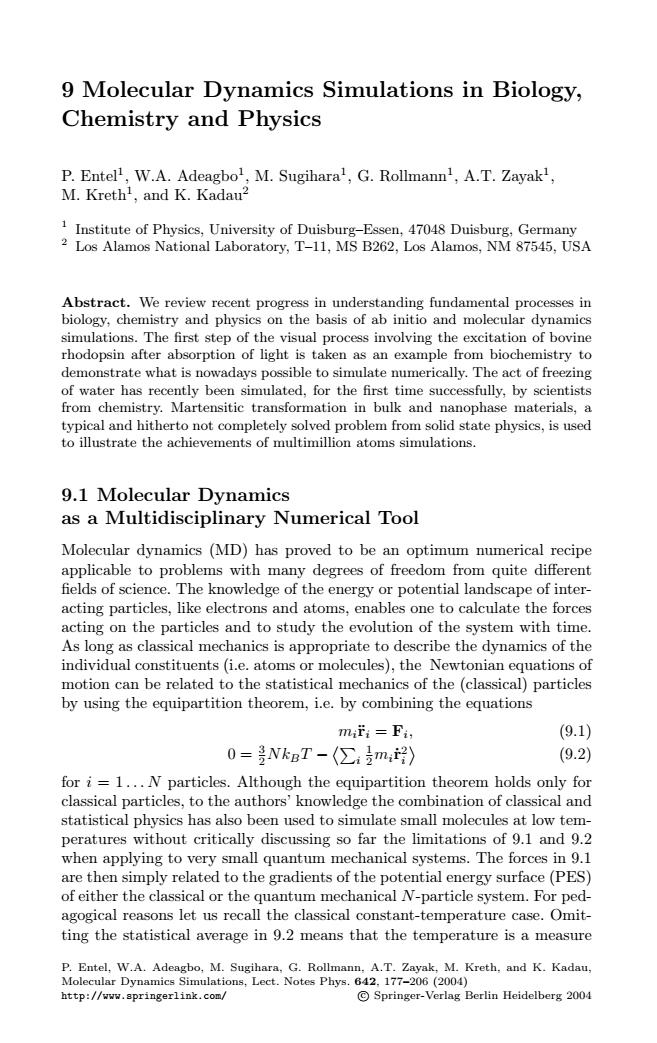正在加载图片...

9 Molecular Dynamics Simulations in Biology, Chemistry and Physics P.Entell,W.A.Adeagbol,M.Sugiharal,G.Rollmann',A.T.Zayak, M.Kreth',and K.Kadau2 1 Institute of Physics,University of Duisburg-Essen,47048 Duisburg,Germany 2 Los Alamos National Laboratory,T-11,MS B262,Los Alamos,NM 87545,USA Abstract.We review recent progress in understanding fundamental processes in biology,chemistry and physics on the basis of ab initio and molecular dynamics simulations.The first step of the visual process involving the excitation of bovine rhodopsin after absorption of light is taken as an example from biochemistry to demonstrate what is nowadays possible to simulate numerically.The act of freezing of water has recently been simulated,for the first time successfully,by scientists from chemistry.Martensitic transformation in bulk and nanophase materials,a typical and hitherto not completely solved problem from solid state physics,is used to illustrate the achievements of multimillion atoms simulations. 9.1 Molecular Dynamics as a Multidisciplinary Numerical Tool Molecular dynamics (MD)has proved to be an optimum numerical recipe applicable to problems with many degrees of freedom from quite different fields of science.The knowledge of the energy or potential landscape of inter- acting particles,like electrons and atoms,enables one to calculate the forces acting on the particles and to study the evolution of the system with time. As long as classical mechanics is appropriate to describe the dynamics of the individual constituents (i.e.atoms or molecules),the Newtonian equations of motion can be related to the statistical mechanics of the(classical)particles by using the equipartition theorem,i.e.by combining the equations mifi Fi, (9.1) 0=NkzT-(∑m》 (9.2) for i=1...N particles.Although the equipartition theorem holds only for classical particles,to the authors'knowledge the combination of classical and statistical physics has also been used to simulate small molecules at low tem- peratures without critically discussing so far the limitations of 9.1 and 9.2 when applying to very small quantum mechanical systems.The forces in 9.1 are then simply related to the gradients of the potential energy surface(PES) of either the classical or the quantum mechanical N-particle system.For ped- agogical reasons let us recall the classical constant-temperature case.Omit- ting the statistical average in 9.2 means that the temperature is a measure P.Entel,W.A.Adeagbo,M.Sugihara,G.Rollmann,A.T.Zayak,M.Kreth,and K.Kadau, Molecular Dynamics Simulations,Lect.Notes Phys.642,177-206(2004) http://www.springerlink.com/ C Springer-Verlag Berlin Heidelberg 20049 Molecular Dynamics Simulations in Biology, Chemistry and Physics P. Entel1, W.A. Adeagbo1, M. Sugihara1, G. Rollmann1, A.T. Zayak1, M. Kreth1, and K. Kadau2 1 Institute of Physics, University of Duisburg–Essen, 47048 Duisburg, Germany 2 Los Alamos National Laboratory, T–11, MS B262, Los Alamos, NM 87545, USA Abstract. We review recent progress in understanding fundamental processes in biology, chemistry and physics on the basis of ab initio and molecular dynamics simulations. The first step of the visual process involving the excitation of bovine rhodopsin after absorption of light is taken as an example from biochemistry to demonstrate what is nowadays possible to simulate numerically. The act of freezing of water has recently been simulated, for the first time successfully, by scientists from chemistry. Martensitic transformation in bulk and nanophase materials, a typical and hitherto not completely solved problem from solid state physics, is used to illustrate the achievements of multimillion atoms simulations. 9.1 Molecular Dynamics as a Multidisciplinary Numerical Tool Molecular dynamics (MD) has proved to be an optimum numerical recipe applicable to problems with many degrees of freedom from quite different fields of science. The knowledge of the energy or potential landscape of interacting particles, like electrons and atoms, enables one to calculate the forces acting on the particles and to study the evolution of the system with time. As long as classical mechanics is appropriate to describe the dynamics of the individual constituents (i.e. atoms or molecules), the Newtonian equations of motion can be related to the statistical mechanics of the (classical) particles by using the equipartition theorem, i.e. by combining the equations mi¨ri = Fi, (9.1) 0 = 3 2N kBT − 2 i 1 2mir˙2 i 3 (9.2) for i = 1 ...N particles. Although the equipartition theorem holds only for classical particles, to the authors’ knowledge the combination of classical and statistical physics has also been used to simulate small molecules at low temperatures without critically discussing so far the limitations of 9.1 and 9.2 when applying to very small quantum mechanical systems. The forces in 9.1 are then simply related to the gradients of the potential energy surface (PES) of either the classical or the quantum mechanical N-particle system. For pedagogical reasons let us recall the classical constant-temperature case. Omitting the statistical average in 9.2 means that the temperature is a measure P. Entel, W.A. Adeagbo, M. Sugihara, G. Rollmann, A.T. Zayak, M. Kreth, and K. Kadau, Molecular Dynamics Simulations, Lect. Notes Phys. 642, 177–206 (2004) http://www.springerlink.com/ c Springer-Verlag Berlin Heidelberg 2004�